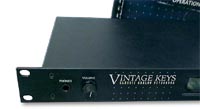Vintage Keys
Classic Analog Keyboards

Overview Overview After the success of the first range of Proteus modules, E-mu Systems began development of a new range in 1992, using the 16-bit Emulator III to sample a range of new instruments. The first sound module of this second range was the Vintage Keys. It was launched in early 1993, and it packed retro analog sounds into a metal rather than a plastic casing with an enhanced Operating System.
The Vintage Keys is a 32 voice multi-timbral sample based synthesizer module that plays classic analog keyboard instruments. It contains hundreds of rich, warm textural sounds from a range of vintage keyboards. There are 249 sampled "instruments" in the base Vintage Keys module. The list includes; Rhodes, Wurlitzer, Hammond, Prophet, Moog, ARP, Mellotron and Oberheim. Acoustic, digital and analog drum kits are also included. There are 384 presets in the base Vintage Keys module. The first 256 presets are held in internal RAM and can be overwritten. The second 128 presets are in ROM and cannot be changed.

Expansion The Vintage Keys module has 8 MB of 16-bit analog samples, selected from the Emulator III sound library and stored in ROM. The base model could be upgraded to Plus status by adding an additional 8 MB ROM stored on a small SIMM card. The card held 185 new samples and was user installable. The part number is 9055, and it cost $299. The upgrade came with 2 new firmware chips. It is unfortunatley now obsolete.
Vintage Keys Plus The expansion ROM provided the following sounds; Dyno Rhodes, Yamaha FM Electric Pianos, Emulator II, Emulator III, Sequential Circuits, Moog, Oberheim, Roland analog synths, ARP analog synths, E-mu SP-1200, Roland DR-55, Roland TR-808, Chapman Stick, Fender P-Bass, Electric Sitar. There are 512 presets in the Vintage Keys Plus. The first 256 are held in internal RAM and can be overwritten. The second 256 are in ROM and cannot be changed.
Filters The Vintage Keys module has 32 dynamic analog-sounding digital filters. These are basic digital filters. Only two types of filter have been implemented; a 2-pole low pass and a 4-pole low pass.
MIDI Implementation E-mu Systems did not implement MIDI bank select, so you can only call up a maximum of 128 presets over MIDI. There is a Program Change Mapping Table to map the 384/512 patches to the 128 available MIDI program change messages. MIDI Overflow can be used to pass notes beyond the basic 32 to another module. The module is 16 part multi-timbral when the Multi mode option is selected.
Configuration The Vintage Keys module implements a classic analog synthesizer - digitally. There are two "oscillators" called Primary and Secondary Instruments. They each can replay any of the 16-bit sampled waveforms. The waveforms are replayed first via a simple digital tone control, then via the 2 or 4 pole low pass digital filter, and finally a digitally controlled amplifier(DCA) and pan.
The amplifier is modified by a dedicated AHDSR envelope generator . There are also two independent LFO's, and an auxiliary envelope generator (DADHSR), which can be patched into the Instruments, Low Pass Filter or DCA. There is also portamento, and cross fade between the two Instruments. Up to 8 sounds can be layered on each key. There are no internal effects.
LCD The Vintage Keys uses the standard green 16 x 2 LCD display, augmented by a MIDI activity LED, and LED's for Master, Edit Menu, Preset, and Home.
Front Panel Controls The Vintage Keys has the standard set of "mark 2" Proteus controls, which are; a power switch, and buttons for master and edit menu selection, home/enter, two cursor controls, data entry and a volume control.
Inside The Vintage Keys has three ASIC chips to deliver the 32 digital filters and sample processing, a Motorola 68000 processor and the standard six 18-bit Analog Devices DAC's (1860's). The software is held in two NM27C010Q 1M-bit EPROM's, providing storage for 256 Kbytes of OS code (twice the size of the Emulator I sample memory !).
There are two spare ASIC slots, which were never used in the Vintage Keys. They enable the Z-plane filters to be created - as in the Morpheus. There is a spare SIMM slot on the right hand side of the motherboard for the 8 MB of ROM samples which make a VK Plus upgrade. The base 8 MB of samples are held in four E-mu designed ROM chips on the motherboard. This is the generic Mark 2 Proteus motherboard design, used from 1992 - 1995.
Factory Presets The Vintage Keys came with a rather unispiring set of presets, however the Plus model has a revised set of 256 presets which are much improved. E-mu also released 4 diskettes each with 256 new presets for downloading to the VK from a PC or Mac.
- 3110 True Keys
- 3111 Power of Syn
- 3112 Vintage ariations
- 3113 Vintage Continues
Diagnostics The Vintage Keys has a full range of internal diagnostics, but beware they can cause speaker damage and the initialisation routine is a one way process.
To enter diagnostics mode, power on with both cursor keys held down. There are 13 modes, which test out all the various components inside the module.
To re-initialize your module, if it locks up, scroll down until you get to the "initialize" option. Hit enter and you will wipe out your user-definable patches and reset the module back to its factory state. Beware! Save your patches first!